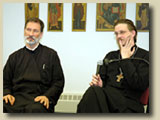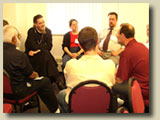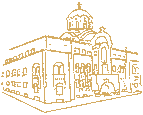|
|
Information
Service of
the Serbian Orthodox Church
June
23, 2005

HOLY SYNOD CALLS ON FAITHFUL TO TRAVEL
TO THE HOLY LAND WITH THE BLESSING OF THEIR BISHOP
The Holy Synod of Bishops of the Serbian Orthodox Church called
on Orthodox faithful to not to travel on pilgrimages to the Holy
Land and other holy places using arrangements by tourist agencies
that do not have the blessing of the bishop in their diocese.

METROPOLITAN AMFILOHIJE LECTURES ON “THE MYSTERY OF THE HOLY
TRINITY – THE MYSTERY OF DIVINE LOVE” His Eminence Metropolitan Amfilohije of Montenegro and the Littoral
gave a lecture on June 21, 2005 on “The Mystery of the Holy Trinity
– The Mystery of Divine Love”. The event was held in the Parish
Hall in Bar and was organized by the Orthodox Church Parish of
Bar as part of its Days of St. Jovan Vladimir event.
“The fullness of the love of the Holy Trinity is revealed in
all that exists. The universe and its beauty and laws attest
to this Divine love. It is tragic and comic when people accept
the belief that the universe exists in and of itself. Man sees
that there is truly something wondrous in the world but it is
difficult for him to admit that this beauty and perfection of
the world could not have been created by accident, and that the
power of Divine love exists, which is revealed in all that exists
in the world, first and foremost, in man’s image and in his personality.
During the course of his life man should work on perfecting himself
and adding to the talents given him by God. Therein lies the
purpose of his existence,” said Metropolitan Amfilohije.
He emphasized that recently the purpose of the stones at Rumija
has been discovered even though some are not pleased by the discovery.
“We regret that there are people who do not understand that this
was no provocation but a sign of our love toward Rumija, toward
these stones, toward the age-old tradition that belongs to all
of us and our love toward all who live near Rumija. We are building
a church at Rumija, and all tradition tied to this church, woven
for centuries, are in the sign of the Venerable Cross and the
church of the Holy Trinity, not St. Jovan Vladimir, as the papers
are erroneously reporting. Who is bothered by our attestation
(of faith) and our love as a portrait of this Divine love toward
which we rush by consecrating this mountain? Who could be bothered
by this love except those who have eyes but do not see, and have
ears but do not hear. Unfortunately, there are such (people)
among the politicians, too, and by their declarations they are
consciously or unconsciously poisoning the people. The Cross
is the symbol whereby we love “all and every” (and) we live with
its love. All is becoming politics, and primitive (politics)
at that,” assessed Metropolitan Amfilohije, adding that today
we are living in an “un-Trinity-like” age.
M.V./Z.V.
Source: Svetigora

REGARDING THE BUILDING OF HOLY TRINITY CHURCH AT RUMIJA The fulfillment of the centuries-old covenant of the residents
of the Bar region (Mikulici, Mrkojevici, Krajina, Spic, Crmnica)
and the general area regarding the construction of a church on
the top of Rumija has recently provoked several tumultuous reactions
by professional, already confirmed opponents of Christ’s Church
in Montenegro.
For centuries the people of this region, Orthodox, Roman Catholic
and Mohammedan, bearing the cross of St. Jovan Vladimir to the
top of Rumija in a religious procession on the feast of the Holy
Trinity, have also carried stones for the building of a church.
Several writers during the twentieth century have recorded the
folk legend, still alive in these parts, that when enough stones
have been collected on the top of Rumija, a church would “fly”
to the scene. According to folk tradition, a church already existed
there.
Only God’s Design knows why this occurred in our time; we can
only speculate. But the fact is that, carrying stones to the
top of Rumija with faith and hope, according to Orthodox ritual,
the Orthodox church that has just “flown in” was built by Orthodox
faithful and Roman Catholics and Mohammedans. It was built by
their faith in God and the living cult and saintly power of St.
Jovan Vladimir. The people, who are in essence honorable, follow
a different logic than political manipulators.
The church that “flew in” at Rumija dedicated to the Holy Trinity,
the God of Love, is the fruit of popular faith in God. No one
carried a stone with great effort and by the sweat of his brow
to the top of Rumija in order to included on the list of patrons
of the church nor has anyone placed a Euro on the icon in the
church in order to later claim it as his property. People are
doing this out of deep conviction that their donation or sacrifice
is beneficial to their soul and the souls of their heirs and
those of their reposed forebears. The stealing of churches and
manipulation regarding their ownership are the fruit of the unbridled
police and political power of Godless persons and theoclasts.
May God save any honorable person, no matter of what faith, of
finding himself in their skin.
The wonderworking holy relics of St. Jovan Vladimir have been
venerated for centuries by Orthodox faithful, Roman Catholics
and Mohammedans filled with the fear of God in the Orthodox Monastery
of Shin Jon (St. Jovan, St. John) near Elbasan in Albania. People
of all three faiths have been coming to Rumija on the feast of
the Holy Trinity for centuries; there were some on this holy
day this year as well, gathered around the new church and the
cross of St. Jovan Vladimir. The church at Rumija is open for
all people of good faith. It is no divider as the people whose
Godlessness has narrowed their consciousness fear. Albania is
at least 30% an Orthodox land and 10% Roman Catholic. How is
it then that only some of our Muslim Albanians are bothered by
a Christian cross at Rumija where it existed previously for centuries
and where we all gathered around it in God’s love? As we will
continue to meet, God willing, in the future. The fact that some
of our ignoramuses and persons with darkened minds spit upon
the church of the Holy Trinity at Rumija, the realization of
a ten century-long desire of many generations, is only an indication
that such persons as are gathered around the so-called Montenegrin
Orthodox Church serve every other purpose except the Living and
True God.
Source: Svetigora

CHURCH AND WORLD – THE CHURCH AND CULTURE  On June 24
St Vladimir’s Seminary successfully concluded its annual summer
institute devoted to the theme "The Church
and Culture." Topics throughout the weeklong event were
colorful and varied, ranging from lectures and discussions about
the Church's engagement with politics, popular culture, technology,
and film to insights into the ways that the second century Church
Fathers and Old Testament prophets confronted and perceived the
world. On June 24
St Vladimir’s Seminary successfully concluded its annual summer
institute devoted to the theme "The Church
and Culture." Topics throughout the weeklong event were
colorful and varied, ranging from lectures and discussions about
the Church's engagement with politics, popular culture, technology,
and film to insights into the ways that the second century Church
Fathers and Old Testament prophets confronted and perceived the
world.
 Several guest faculty members enhanced this year's program with
their expertise and fresh perspectives. The seminary was grateful
for the participation of two keynote lecturers, Hieromonk Irinej
Dobrijevic, consultant to the Holy Synod of the Serbian Orthodox
Church, and Dr Albert Raboteau, professor of religion at Princeton
University. Other esteemed guests who spoke during the course
of the week were His Grace, Bishop Savas of Troas, chancellor
of the Greek Orthodox Archdiocese of America, and Dr Aristotle
Papanikolaou, assistant professor of theology at Fordham University.
Bishop Savas also presided and preached at the Divine Liturgy
of the Feast of St John the Baptist, on the closing day. Several guest faculty members enhanced this year's program with
their expertise and fresh perspectives. The seminary was grateful
for the participation of two keynote lecturers, Hieromonk Irinej
Dobrijevic, consultant to the Holy Synod of the Serbian Orthodox
Church, and Dr Albert Raboteau, professor of religion at Princeton
University. Other esteemed guests who spoke during the course
of the week were His Grace, Bishop Savas of Troas, chancellor
of the Greek Orthodox Archdiocese of America, and Dr Aristotle
Papanikolaou, assistant professor of theology at Fordham University.
Bishop Savas also presided and preached at the Divine Liturgy
of the Feast of St John the Baptist, on the closing day.
The six-day forum, from June 19-24 attracted nearly fifty participants
who each followed one of two tracks: pastoral practice or liturgical
music. Participants in both tracks kept a busy schedule each
day—worshiping, eating meals together, attending lectures, participating
in discussions, and using the seminary's library resources. Dr
Peter Bouteneff, who organized this year's program, commented
that the topical theme, the top-notch faculty, and the high-caliber
participants, all conspired to make this an especially vibrant
and fascinating week.
The liturgical music track, coordinated by full-time institute
faculty members Mr Mark Bailey, Ms Helen Erickson, and Dn Kevin
Smith, offered practical training as well as theological reflection
in many areas of liturgical music. Participants in the liturgical
music track—divided into beginning and advanced groups—studied
conducting, the eight tones, composition, vocal techniques for
church reading, and church rubrics. Participants in the liturgical
music track were responsible for all the liturgical services
during the institute, both reading and singing responses.
Held each
year in June, the Liturgical Institute of Music and Pastoral
Practice (informally called the "summer institute")
is a way for the seminary to serve the Church by inviting many
to take advantage of the seminary's resources. It provides a
forum for clergy and laypeople to learn more about their faith
and Church practice through a week of worship, lectures, discussions,
and activities.
Source:
www.svots.edu

[Serbian
Translation Services]

Copyright © 1999-2004 by
The Information Service of the Serbian Orthodox Church
11000 Belgrade
Kralja Petra I no.5
+381 11 3282 596
e-mail
|

